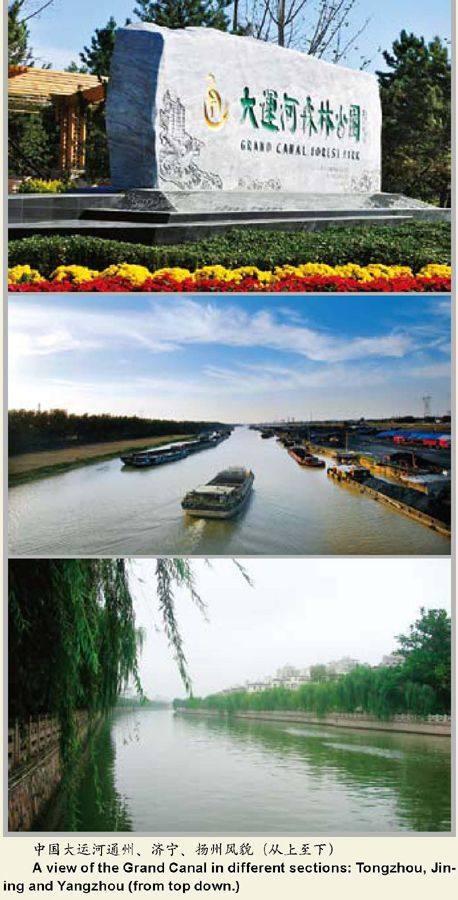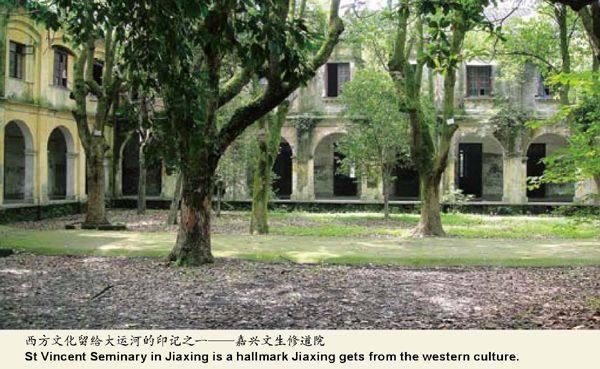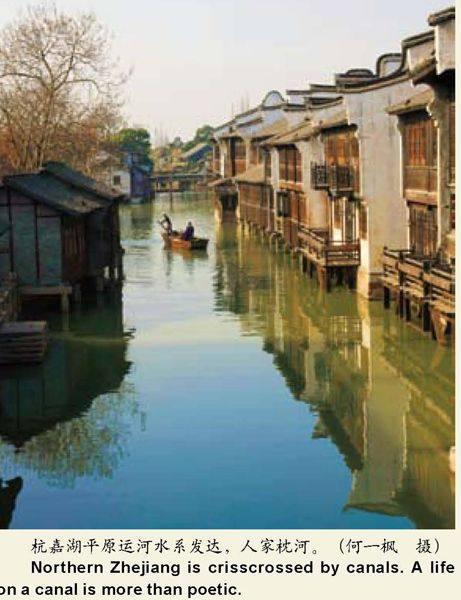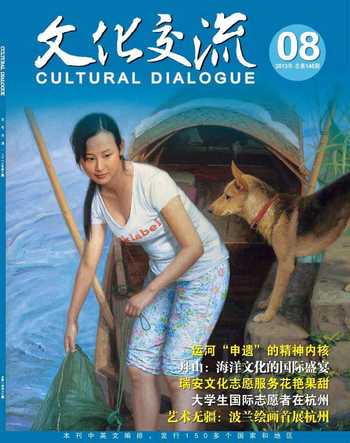中國大運河:中外文化交流走廊
魏大鍋



大運河是一條中外文化交流走廊。交流時間之長,地域跨度之大,影響力度之深,是中國文化歷史上值得書寫的重要篇章。
歷史上,中國大運河是一條中外文化交流的走廊。在這條走廊里,交流是雙向的:早期,主要是中國文化輸出;后半期,則是外國先進文化輸入。
大運河的輸出
在舉世聞名的《馬可·波羅游記》中,馬可·波羅(1254-1324)描述了他看到的長江以北運河:忽必烈已經開通了從瓜洲到大都的水路。這條水路是一條寬而深的航道,把江河、湖泊連接起來。《游記》還記錄了他在山東一帶看到的運河城市如臨清、濟南和東平等地的情況。
近代西方人進入中國、并對中國逐漸產生影響,最早大約可以追溯到明代。這個節點與世界歷史的發展有關。史學家一般把哥倫布1492年第一次航海當作中世紀和現代的轉捩點。此后,西北歐沿海強國通過戰爭、掠奪、貿易、傳教、建立殖民地等方式逐漸向外擴張。至19世紀,歐洲在文化、政治、經濟、軍事等各方面迅猛發展。而明清時期的中國早已繁華,舉世聞名,引發了西方人的關注,當時外國人來中國,首先接觸的往往就是大運河。前往北京的外國使節、傳教士、旅行者等多取道于此。大運河沿線的水利工程、城鎮鄉村和風土民情,給外國人留下了深刻印象,他們的作品中的觀察與描述無疑有助于西方加深對中國的認識。
1488年,朝鮮人崔溥(1454-1504)在海上遭遇風浪,漂流14天后在寧波附近獲救登岸。之后,他沿浙東運河、京杭運河前往北京,歷時44天,成為明代走完大運河全程的第一個朝鮮人。他用中文寫下的《飄海錄》成為彌足珍貴的大運河史料。
日本僧人策彥周良(1501-1579)于1539年和1547年作為日本遣明使副使和正使來中國,在中國逗留5年多,多次沿大運河南來北往。他將兩次來華經歷寫成《初渡集》《再渡集》。這兩本記事性詩文集是中日關系史上的重要文獻。
意大利耶穌會傳教士利瑪竇(1552-1610)在明萬歷年間來中國。他從南京出發沿運河前往北京,沿途經過許多大運河城市。對明代運河漕運的有關情況,他甚感興趣,在《利瑪竇中國札記》中做了詳細記載。
除了利瑪竇之外,明清時期有不少來中國的傳教士將他們在中國的所見所聞寫成書,在歐洲出版,其中不乏關于大運河的詳細描述。這一時期還有不少中國傳統典籍經翻譯而介紹到歐洲。英國傳教士、漢學家理雅各(1815-1897),是牛津大學第一位中國語言和文學教授。他不僅翻譯中國典籍,還著書立說,系統論述孔子、孟子以及中國的文學和宗教。在牛津任職之前,他于1873年4月從上海出發,坐船經大運河訪問北京,回程時去了泰山和曲阜,之后經大運河返回上海。他對中國文化的譯介,可以聽到大運河的水聲。
但外國人對大運河的描述,并非僅限于見聞。他們目的性很強,頗有系統性,撰寫專門報告,研究大運河,研究大運河對中國的政治、經濟、文化的影響。
英國學者吉恩斯在1890年在倫敦出版《世界各國的水道和水運》中提到中國的大運河,認為“就許多方面來說,世界上最值得注意的是中國的大運河。它也是所有其他運河中,我們了解最少的。”1895年出版的《時代世界地圖集》中載有中國大運河的地圖。1912年10月,美國《國家地理雜志》刊登F.H.金的學術論文,題目是《中國的運河,人類的奇跡》,該文對江南運河地區河網密布做了詳細的記錄。1917年在倫敦出版的《百科全書,中國》有關于大運河的詞條。
大運河的接納
通過大運河,西方對中國有所了解。而現代西方文化最早進入中國,所謂西風東漸,正是沿著大運河而播揚。
法國傳教士金尼閣(1577-1628)在利瑪竇逝世后不久抵達北京,并發現了利瑪竇的札記。明萬歷四十年(1612),金尼閣返回歐洲,他身著中式服裝出入于各國公共場合,以感人肺腑的演講宣傳利瑪竇和其他在華傳教士們的功績,并著手整理翻譯《利瑪竇中國札記》。該札記于1615年在德國出版,掀起了歐洲的“中國熱”。當時,大批歐洲年輕傳教士申請赴華,德國人湯若望(1592—1666)即是其中的一位。湯若望歷經明清兩代,為西學東漸做出重大貢獻。1618年,金尼閣離開里斯本第二次來華時,攜帶在歐洲各國募集的7000冊圖書和儀器,從杭州沿大運河抵達北京,建立了中國第一個外國圖書館。金尼閣本人估計書籍和儀器在離開歐洲時價值1萬金幣。金尼閣擬定了一個龐大的計劃,聯絡艾儒略、徐光啟、楊廷筠、李之藻、王徵、李天經等中外人士共同翻譯出版這些書籍。金尼閣二度來華后,先在南方進行傳教和譯著工作,較長時間住在杭州,并以杭州為中心沿大運河到嘉定等地活動。1628年,金尼閣在杭州去世,把“西書七千部”介紹給中國知識界的計劃流產,大部分書籍流失。1938年,北平天主教堂整理藏書樓時發現了殘存的數百部,其中有哥白尼的《天體運行論》和開普勒的《哥白尼天文學概要》等重要的科學典籍。
鴉片戰爭之后,外國傳教士大量進入中國。在19世紀末20世紀初,浙北的運河城市早已成為一些外國傳教士在中國活動的基地和大本營。嘉興的文生修道院西臨大運河,1902年建成之后到1908年,它是天主教中國遣使會的唯一總修院。嘉興的天主教堂在1930年建成,號稱中國第一、遠東第三大教堂。文生修道院和天主教堂均為浙江省省級文物保護單位。
曾經擔任美國駐華大使的司徒雷登(1876-1962),出生在杭州。父母均是美國南長老會在杭州的傳教士。南長老會海外傳教的第一個基地是杭州,以后沿大運河逐步向嘉興、蘇州、江陰、南京等地擴展。1904年,司徒雷登在美國結束學業,回到杭州開始傳教,他的傳教足跡正是沿大運河迤邐北去。
19世紀后半期起,大運河沿岸城市建立了相當數量的教會學校。教會學校最直接的貢獻就是把現代教育模式移植到了中國。經過多年經營,在整個20世紀上半葉,13所教會大學和幾十所教會中學為中國融入現代文明、為教育和社會的現代化作出了重大貢獻。而這些學校中相當一部分位于大運河沿線的城市或者與運河關系甚為密切的城市。
教會大學各校名師云集,各有自己的個性和特殊專業,辦學有聲有色,學生才俊輩出。燕京大學的社會學系和新聞系,在全世界都有影響力。在二戰后的“東京審判”中,中國法官中的大部分都是畢業于東吳大學。醫科更是教會大學的強項,協和醫學院、湘雅醫學院以及齊魯大學的醫科,為中國培養了最優秀的醫學人才。
1901年,清政府廢除漕運,大運河似乎失去了歷史作用,但因為依靠大運河為廣闊腹地而有機會迅速成為中國最大港口和最繁華城市的上海,中外文化交流在20世紀結出碩果。
很多人驚異于19世紀末20世紀初江浙一帶大量涌現文人政客這一現象,細究起來,卻不難看出大運河的作用。正是大運河使得整個地區經濟繁榮,積聚起深厚的文化底蘊,從而使得中外文化交流得以在各個層面廣泛深入進行,人才輩出是理所當然的。
(除署名外,本文圖片由作者提供)
Grand Canal: Corridor of International Cultural Exchanges
By Wei Daguo
Historically, the Grand Canal of China served as a corridor of international cultural exchanges. The exchanges were mutual: in the early centuries, Chinese culture went out to the outside world; largely in the Ming (1368-1644) and the Qing (1644-1911) dynasties, foreign cultures began to come in.
Prosperity of the Grand Canal
One of the earliest description of the Grand Canal of China was made by Marco Polo (1254-1324), who traveled across China for years. He mentioned the Grand Canal that connected the Yangtze River and Dadu, the present day Beijing, the capital of the Yuan Dynasty (1279-1368). There are detailed descriptions in the travelogue about the canal towns in Shandong Province.
It was in the Ming Dynasty that westerners began to flood into China on a large scale. Their arrival in China followed Columbus epoch-making travel. Afterwards, the west expanded outward through wars, trade, religious missions, colonialism, profits through looting. By the 19th century, Europe played a big role in the world. Europeans came to China, allured by the legendary wealth of China. During these centuries, foreign diplomatic envoys, missionaries, and travelers usually traveled on the Canal to reach Beijing. They were deeply impressed by the size and the grandeur of the Grand Canal. Their reports deepened the western understanding of the great country in the orient.
The Italian missionary Matteo Ricci (1552–1610) came to China during the reign of Emperor Wanli of the Ming. He traveled on the Grand Canal from Nanjing to Beijing and chronicled his canal tour in detail in his book. In addition to Matteo Ricci, other missionaries also wrote books and introduced their China experiences to Europe. Some missionaries even provided Europeans with translations of Chinese classics. James Legge (1815-1897), a noted Scottish sinologist and missionary in Malacca and Hong Kong for 33 years and first professor of Chinese at Oxford University for 21 years. He translated Chinese classics into English and wrote books on Confucius and Mencius as well as Chinese literature and religion. Before he took office at Oxford, he started in April 1873 in Shanghai to visit Beijing. He traveled on the Grand Canal. On his way back, he visited Mount Tai and Confucius Temple. Then he traveled on the Canal again on his way back to Shanghai.
By the late 19th century and early 20th century, the Grand Canal of China had become a constant subject in encyclopedias, map atlases, and academic books published in the west.
Western Culture Came In
While information on the Grand Canal went abroad, westerners brought western culture into China. In China scholars describes the phenomenon through the Ming, the Qing and the Republic years in words “Western Winds Blow into East.” The Grand Canal played a big role in this cultural exchange between east and west.
Nicolas Trigault (1577-1629) arrived in Beijing shortly after Matteo Ricci passed away. A French missionary and sinologist, he was an influential westerner in China. He toured China before going back to Europe to report to the Pope on missionary affairs in China. In 1612, he returned to Europe. He traveled across Europe, publicizing the work of the Jesuit missions in China and raising funds. He appeared in public dressed in the Confucian gown. It was during his European tour that he edited and translated Matteo Riccis China Journal. The work was published in Augsburg in 1616 and later it was translated into many European languages and widely read. Twenty-two young missionaries followed him back to China. Johann Adam Schall von Bell (1591-1666) was one of the 22 missionaries. He served the emperors of the Ming Dynasty and the Qing Dynasty.
Nicolas Trigault brought 7,000 books and instruments to China and traveled on the Grand Canal all the way from Hangzhou to Beijing. He set up the first foreign library in China. He planned to translate the books into Chinese in collaboration with a group of elite Chinese scholars. He died in Hangzhou in 1628 and he was buried in Hangzhou. His translation project aborted and most of the books dissipated. In 1938, hundreds of books were found in a library of a Catholic church in Beijing. These books were part of the 7,000 books Trigault had brought to China.
After the Opium War in the mid 19th century, missionaries flooded into China. In the late 19th century and early 20th century, canal cities and towns in northern Zhejiang were home to headquarters of some foreign missionaries in China. St. Vincent de Paul Seminary, a Catholic abbey in Jiaxing, served as the only seminary for all the missionaries in China from 1902 to 1908. The Catholic Church in Jiaxing, built in 1930, was the largest church in China and the third largest in Far East at that time. The two sanctuaries are now cultural relic units under provincial protection.
John Leighton Stuart (1876-1962) was the first President of Yenching University and later United States ambassador to China from 1946 to 1949. Born in Hangzhou in 1876, he was son of Presbyterian missionary parents based in Hangzhou and reached out to believers around Hangzhou and areas along the Grand Canal north of Hangzhou. John Leighton Stuart grew up on Hangzhou and spoke the local dialect. After he finished education in the United States, he came back to Hangzhou and started missionary work in 1905. His constituents were residents in canal towns and villages.
From the late 19th century, church schools in canal towns and cities mushroomed, contributing to the modernization of education in China. In the first half of the 20th century, there were 13 universities, dozens of schools in the primary and secondary education founded and operated by foreign churches. The majority of these schools were situated in canal towns and cities or cities closely associated with the Grand Canal. Church-associated universities turned out talents in various fields and these graduates played a big role in the modernization of China in the 20th century.
The Grand Canal went out of fashion in 1901 when the Qing government aborted the centuries-old tributary system. However, the Grand Canal continued to play a big part in regional economy in eastern China. Shanghai, which grew out of nothing after the Opium War, rapidly became an international metropolis in the early 20th century. Given its geographic position in the canal area, Shanghais rise to the international status was closely associated with the Grand Canal. When one examines the cultural history of the Yangtze River Delta in the late 19th century and early 20th century, one would wonder why there was a galaxy of cultural celebrities in the region. They all came from the canal region, enriched and shaped by cultural exchanges between China and the outside world made possible by the Grand Canal.

